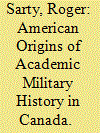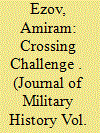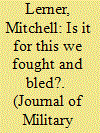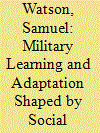|
|
|
Sort Order |
|
|
|
Items / Page
|
|
|
|
|
|
|
| Srl | Item |
| 1 |
ID:
159440


|
|
|
|
|
| Summary/Abstract |
C. P. Stacey (1906–1989), Canada’s first academic military historian, owed his career to opportunities in the United States. He was at an academic dead end when Princeton University provided a Ph.D. fellowship and employment. Carnegie Endowment funding allowed him to publish his thesis as Canada and the British Army, the book that secured his future. It remains the foremost account of how confrontation between Britain and the United States in the 1840s–1860s brought the creation of the modern Canadian state in 1867, which helped set the course for rapprochement and then alliance among the three nations.
|
|
|
|
|
|
|
|
|
|
|
|
|
|
|
|
| 2 |
ID:
159441


|
|
|
|
|
| Summary/Abstract |
The crossing of the Suez Canal by the Israel Defense Forces (IDF) during the Yom Kippur War of October 1973 encompassed the toughest and bloodiest battles that the IDF had ever known. Because of the characteristics of the forces and missions involved, it was the ultimate expression of a multi-dimensional battle. During the campaign, there were battles to achieve breakthrough and approach clearing, armor versus armor battles, water obstacle crossings, bridging, establishment of a bridgehead, all featuring complicated logistics. Most of the branches of the IDF became involved and a full range of combat apparatus was deployed, including some items which had not been fully developed and on which training had not been suitably completed. The central problem of the crossing campaign was the “orchestration” of new fighting materials—the means to achieve a water crossing—into a battle that had not been foreseen. Alongside organization, fighting doctrine, and training, this kind of orchestration also demanded innovative leadership and command and control, effective communications, and the ability to cope with a complex and unexpected battlefield. The aim of this article is to test and compare the objectives, planning, and execution of two crossing campaigns—that of the Egyptian Army and that of the IDF. The differences in doctrine stemmed from the choice of strategic objectives and from the adoption of differing combat doctrines.
|
|
|
|
|
|
|
|
|
|
|
|
|
|
|
|
| 3 |
ID:
159443


|
|
|
|
|
| Summary/Abstract |
The relationship between the Korean War and the African American civil rights movement is one that has been largely overlooked in the historical literature. This paper traces the internal struggles of the African American community during the war to examine its role in the evolution of the movement. It focuses in particular on the battlefield treatment of African American soldiers and the response of the home front to suggest that the Korean War was an important event in turning the civil rights movement towards a more confrontational position.
|
|
|
|
|
|
|
|
|
|
|
|
|
|
|
|
| 4 |
ID:
159437


|
|
|
|
|
| Summary/Abstract |
Despite the romanticized image of a Cossack as a free mounted warrior living in the steppe serving under elected atamans, during the reign of Ivan IV (1533–1584) Muscovite “State Cossacks” lived in urban enclaves and fought under the command of government-appointed colonels. Most were infantry, but some were cavalry. Probably a majority fought with sabers, lances, and bows, but at least a sizeable minority used guns. During the 1570s, between 5,000 and 6,000 State Cossacks served in the Russian army. Probably the total was between 7,000 and 7,500, fewer than the number of musketeers.
|
|
|
|
|
|
|
|
|
|
|
|
|
|
|
|
| 5 |
ID:
159438


|
|
|
|
|
| Summary/Abstract |
The regular army, rather than citizen-soldiers, drove nineteenth-century U.S. military history (apart from the Civil War). The national standing army was crucial to the defeat of Native Americans, and more important than citizen-soldiers or white pressure on Native American subsistence. Despite new circumstances west of the Mississippi River, the contexts and methods of this warfare did not fundamentally change, and learning (or relearning) and adaptation were crucial to the army’s success. The most important learning was strategic, particularly in lessons of patience, persistence, and control over the initiation and conduct of warfare, and responded to external, non-military contexts (the tug of war between citizen land hunger and tax aversion). Army learning and adaptation did not win these wars by itself, but it facilitated the effective and successful use of force at a cost the nation was willing to pay, and reduced the incidence of large-scale atrocity in comparison with operations by citizen-soldiers.
|
|
|
|
|
|
|
|
|
|
|
|
|
|
|
|
| 6 |
ID:
159439


|
|
|
|
|
| Summary/Abstract |
This article questions the traditional interpretations of how the Wilderness, a forest some sixty miles south of Washington, D.C., affected strategy and combat during the Battle of the Wilderness, 4–6 May 1864. It argues that other factors besides the Wilderness determined the Federal and Confederate commanders’ strategies. It also undermines the contentions that the Confederates held a tactical edge in the Wilderness and that the Wilderness was a unique landscape.
|
|
|
|
|
|
|
|
|
|
|
|
|
|
|
|
| 7 |
ID:
159442


|
|
|
|
|
| Summary/Abstract |
By analyzing the use of baton rounds as riot control weapons during the Northern Ireland “Troubles,” this article explores the British Army’s difficult transition from colonial counterinsurgency to a war in which the army faced greater public sensitivity and scrutiny than before. British forces tried to minimize the use of force against rioters by introducing new non-lethal baton rounds. But soldiers often disregarded the rules of engagement by firing the weapons excessively and at unsafe distances, which resulted in injuries and deaths that infuriated the local population. The technological innovation of baton rounds thus undermined British counterinsurgency efforts.
|
|
|
|
|
|
|
|
|
|
|
|
|
|
|
|
|
|
|
|
|